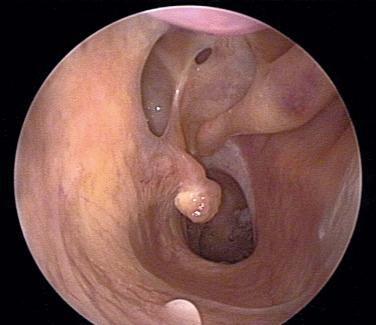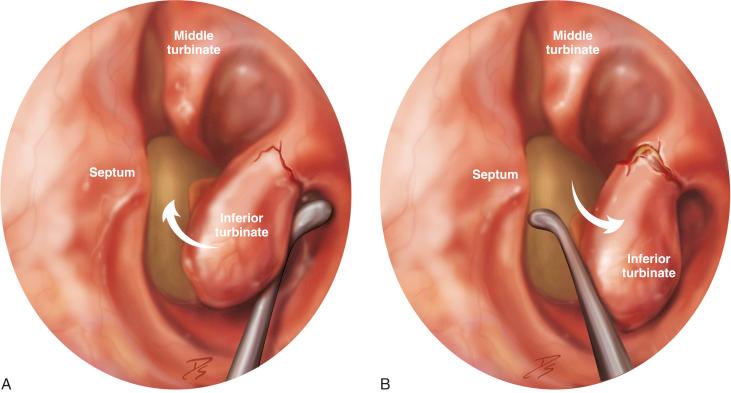Physical Address
304 North Cardinal St.
Dorchester Center, MA 02124
Turbinate surgery is performed most commonly to treat obstruction. Examples are nasal airway obstruction caused by oversized inferior turbinates and obstruction of sinus drainage by a lateralized middle turbinate or concha bullosa.
The middle and inferior turbinates are dynamic functional structures within the nasal cavity and sinuses. Anatomic variations and/or dysfunction commonly lead to the need for turbinate reduction or resection.
Total resection of an inferior turbinate is the extreme and is generally not recommended in most cases except for neoplasm resection ( Fig. 2.1 ).

The turbinates comprise a set of three paired laminar structures that arise from the lateral wall and roof of the nasal cavity.
The inferior turbinate is its own laminar structure; the middle and superior turbinates form part of the ethmoid bone.
Each turbinate is composed of a bony base covered by respiratory epithelium with an intervening submucosal layer.
Although the functions of the turbinates are not completely understood, it is known that they help to optimize oxygen exchange in the lungs by warming, humidifying, and filtering inspired air.
The turbinates also assist in maintaining directional and laminar airflow in the nose and contribute to olfaction by directing air toward the olfactory cleft.
The submucosa of the inferior turbinate contains a complex system of capacitance vessels that allow for selective engorgement or decongestion of the submucosal tissue. This change in turbinate thickness alters both the cross-sectional diameter of the nasal airway and the surface area of the turbinate.
Fluctuations in vasomotor tone of the turbinates may be based on the temperature and humidity of inspired air and overall sympathetic tone of the individual.
The cross-sectional area of the nasal cavity can also be altered by inflammatory swelling of turbinate soft tissue.
When considering turbinate surgery, the surgeon should always remember that the turbinates are functional organs.
Techniques should target the submucosal tissue, leaving the functional mucosa intact and undisturbed.
Bleeding can be minimized by timely injection of 1:100,000 epinephrine (usually in combination with an anesthetic such as 1% lidocaine).
Inferior turbinate outfracture does not address the vasoactive components of turbinate hypertrophy and is generally not sufficient as a standalone procedure.
The surgeon should remember that the anterior-most 2 cm of the inferior turbinate account for the majority of its impact on patency of the nasal airway.
Dissection posteriorly can injure larger vessels branching off the sphenopalatine artery as they enter the turbinates posteriorly.
Radiologic imaging is not necessary to assess the inferior turbinates.
For the middle turbinates, closely evaluate the axial and coronal computed tomographic scans.
Identify the inferior and middle turbinates. Identify the nasolacrimal duct and take note of its location in relation to the inferior turbinate and inferior meatus.
Identify the presence of any concha bullosa and note the anatomy of the middle turbinate as it inserts on the skull base. Prior surgical manipulation of the middle turbinate may predispose to middle turbinate lateralization, which may adversely affect drainage of the frontal or ethmoid sinuses.
Assess the size and patency of the nasal cavity as well as the possible contributions of the inferior and middle turbinates, nasal septum, and other anatomic structures on nasal obstruction.
0-degree and 30-degree endoscopes
Boies-Goldman elevator
Freer elevator
Microdébrider with turbinate blade or pediatric cutting blade
Monopolar or bipolar radiofrequency ablation device (optional)
Monopolar needle electrocautery device (optional)
Sickle knife or scalpel
Straight and angled through-cutting forceps
Endoscopic scissors
Care should be taken when operating on the turbinates, with the goal being to preserve or restore normal function.
The most conservative procedure that can accomplish this goal is the best option. Techniques involving greater degrees of tissue resection or ablation should be reserved for treatment failures.
Thermal injury caused by aggressive soft tissue reduction of the inferior turbinate can result in problematic complications such as mucosal sloughing and crusting.
Surgery directed at the more posterior portions of the inferior or middle turbinate is generally less necessary to improve the nasal airway but can be associated with an increase in the risk of arterial bleeding.
Overresection of the inferior turbinates may, in rare cases, lead to paradoxic nasal obstruction or empty nose syndrome (see Fig. 2.1 ). Therefore, a judicious approach to turbinate resection is indicated.
Nasal obstruction is the primary indication for inferior turbinate surgery.
Some evidence exists to support the use of inferior turbinate surgery to improve the symptoms of allergic rhinitis.
Other indications include maxillary sinus hygiene, chronic rhinitis, and snoring.
Surgery of the inferior turbinate can be classified into a sequence ranging from least invasive to most invasive: outfracture, soft tissue resection/reduction, resection of bone and soft tissue, and full-thickness resection of the anterior portion.
Outfracture is the simplest and least invasive of the inferior turbinate procedures because no tissue is removed.
Because outfracture does not modify soft tissue, the vasoactive components of turbinate hypertrophy are not addressed by this technique.
The inferior turbinate bone attaches to the lateral nasal wall at an angle, so that outfracture requires pressure on the bone in an inferior-lateral, not just lateral, direction.
Gentle technique is necessary to avoid injury to the orifice of the nasolacrimal duct in the lateral wall of the inferior meatus.
Under direct visualization, place a Freer or similar elevator within the inferior meatus and fracture the turbinate upward and medially ( Fig. 2.2A ).

Place a Boies-Goldman or Freer elevator on the superior and medial surface of the turbinate and outfracture it laterally and inferiorly ( Fig. 2.2B ).
Many techniques can be used to address the soft tissue of the inferior turbinates, which have their own advantages and disadvantages ( Table 2.1 ).
Thermal ablation: (1) Electrocautery, (2) Laser
Radiofrequency: (1) Bipolar, (2) Unipolar
Microdébrider
| Surgical Technique | Advantages | Disadvantages |
|---|---|---|
| Electrocautery/diathermy | Minimally invasive | Unmeasured delivery of energy May necrose mucosa if not careful |
| Laser ablation | Minimally invasive May be performed in the office |
Equipment costs Not mucosal sparing Long-term results vary |
| Radiofrequency (bipolar, unipolar) | Minimally invasive Minimal discomfort Mucosal sparing |
Less control over degree of tissue reduction Equipment cost |
| Microdébrider | Can sculpt turbinate, especially for severe hypertrophy Can be performed in clinic or operating room Mucosa preserved |
Risk of bleeding |
Some devices that use thermal or radiofrequency energy remove tissue to some degree but work largely by causing wound contraction.
Most, but not all, techniques target the submucosal tissue while leaving the functional mucosa intact.
Submucosal needle electrocautery is, in many ways, the simplest of these techniques but is also very imprecise.
Laser ablation essentially resurfaces the mucosa, with some ablation of the submucosa as well. The equipment costs can be substantial.
Ablation and electrocautery both subject the overlying mucosa to thermal injury, which sometimes results in mucosal sloughing and crusting.
Radiofrequency devices for performing inferior turbinate reduction can be either unipolar or bipolar; no appreciable difference in outcomes is seen with the two methods.
The impact of soft tissue reduction on the nasal airway is largely due to alterations in the anterior portion of the inferior turbinate. Reduction posteriorly does not significantly improve the nasal airway and can significantly increase the risk of bleeding.
Several careful analyses of outcomes following inferior turbinate surgery have been performed over the last few years.
A large study comparing subtotal turbinectomy, laser cautery, electrocautery, cryotherapy, submucosal resection, and submucosal resection combined with outfracture found the best outcome at 6 years of follow-up in patients treated with submucosal resection combined with outfracture.
Bipolar radiofrequency has been proven safe and effective in both adult and pediatric populations.
Long-term (2-year) follow-up of radiofrequency (RF) turbinate reduction for allergic and nonallergic inferior turbinate hypertrophy has shown improvement in olfaction, decreased nasal resistance and subjective improvement in nasal obstruction.
Long-term (10-year) follow-up of microdébrider reduction has shown symptom improvement in 93% of cases. Endoscopy, mucociliary clearance time, and anterior rhinometry remained improved over the long term.
Comparisons between bipolar radiofrequency ablation and microdébrider submucosal resection have shown improvement in symptoms with both techniques, with the microdébrider technique yielding greater improvement over a longer period of time.
Under direct visualization, either with a nasal speculum or 0-degree endoscope, inject the inferior turbinate with 1% lidocaine with 1:100,000 epinephrine.
Become a Clinical Tree membership for Full access and enjoy Unlimited articles
If you are a member. Log in here